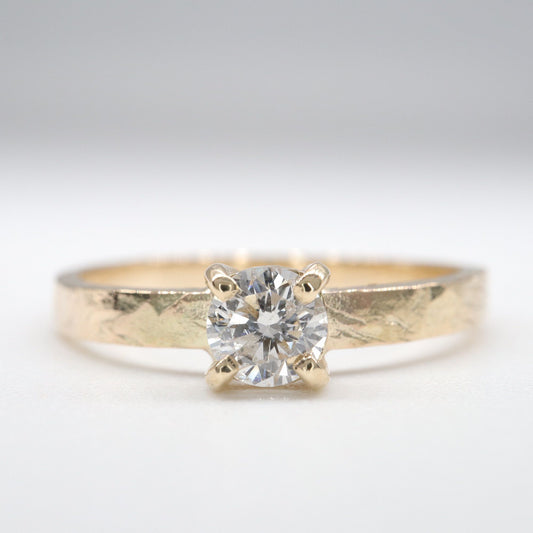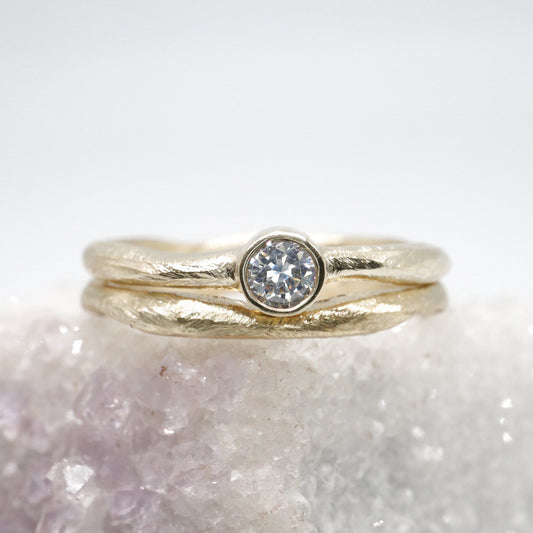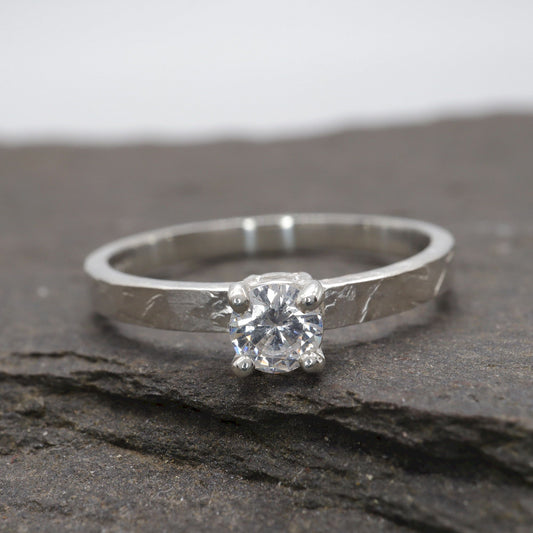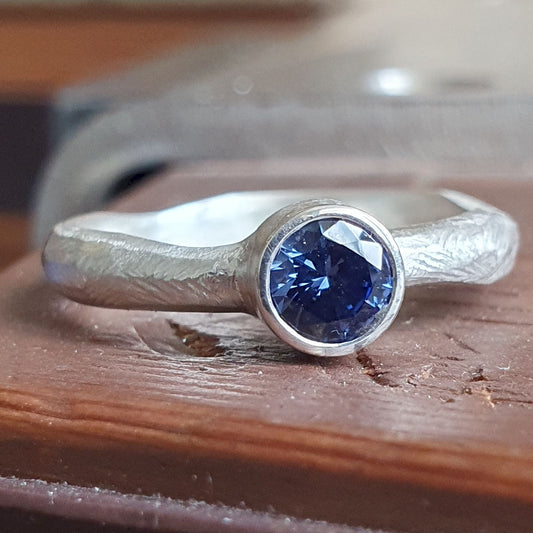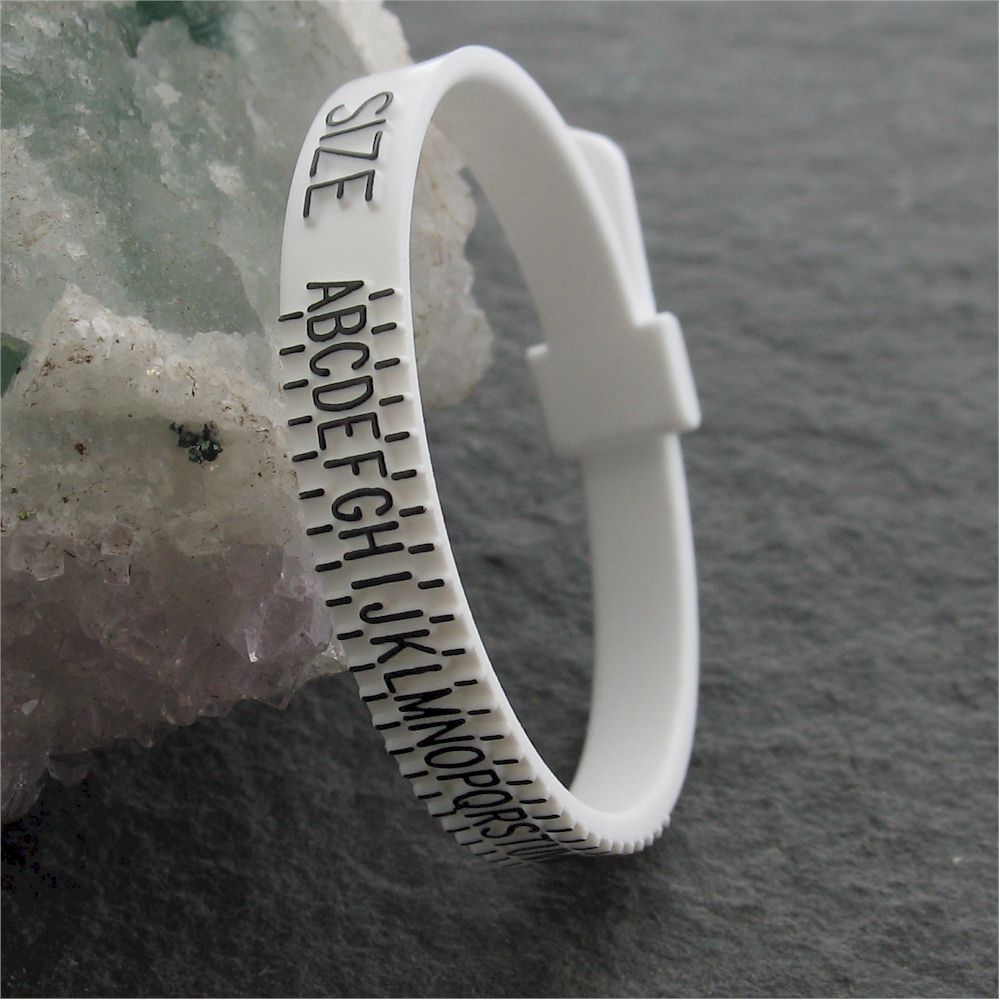
How to measure Your ring size at home.
This is probably one of the most frequently asked questions I am asked: how to measure your ring size?
And the reason is obvious. When we buy a wedding or engagement ring, the least we can expect is that the purchasing and delivery process be as perfect as it can be. This, of course, involves choosing the ideal ring size.
We all love surprises, and we know how difficult it is to buy a ring for a loved one without asking their size because that would be too obvious and we don't want that, do we?
So, let's see in detail how to measure your ring size at home and save the day!

How can I tell what size my ring is?
Ring size is different for each person and varies greatly between men and women, generally ranging from size J to Z.
A standard size for women varies from J to Q (N is the most common size). For men, the average sizes range between S and X, with U being the most common men's ring size.
How do I measure my ring size at home?
There are three simple methods to find your ring size at home without problems. Although it is important to note that these measurements will not be perfect if done only once. Why? Simply because the size or thickness of our fingers varies greatly depending on the temperature and time of day.
So, unless you have another ring to compare the size, it is better to measure a couple of times before declaring a definitive ring size.
Option 1. Using Some string
One of the most used methods to find your ideal ring size is to use a small string, strip of paper, or dental floss and use it to measure the circumference of your finger. To do this, you only need these materials:
- String, dental floss, or strip of paper
- Marker or pen
- Ruler
- Tape
Once you have them, you can follow these steps:
- Select the material of your choice, in this case, you can choose a small string, strip of paper, or dental floss to measure.
- Wrap the base of your finger with the material you chose.
- Make a mark exactly where the two ends of the material meet (i.e., where they overlap).
- Stretch out the material you chose with the marks already made.
- Place the stretched-out material next to a ruler and measure the length in millimetres from the initial mark to the end.
- The measurement in millimetres will be the circumference of your finger.
Option 2. Paper
If you want to make a slightly more accurate measurement, you can make a try on ring as follows:
- Use a strip of paper and some tape to make a try on ring.
- Adjust the try on ring on the finger until it feels comfortable, neither tight nor loose.
- Cut the strip and measure the length in millimetres as indicated in step 5.
By following these steps, you will be able to roughly determine the circumference of your finger and find your ring size.
Option3. Ring sizer
Another more accurate option is to purchase one of our ring sizers. Its quick and easy and can be used many times over.
It is a plastic ring gauge which works like a belt around your finger. Simply push the end through the buckle to form a round ring shape. Slide the ring sizer onto your finger and pull to give a comfortable fit, making sure that it still slips back over the knuckle.
You can find our ring sizer here.
Using an existing piece of Jewellery.
An alternative to know the ring size is a professional consultation
If your partner or special person already has rings in their size, you can enlist the help of an accomplice to get one of them and take it directly to a professional jeweller.
In a jewellery workshop, professionals can use precision tools to determine the ideal standard size for the ring.
This is not a "home" method, but it is an interesting way to know the ring size when surprising someone you love without directly asking their size.
It is important to note that each country and even different designer brands can have their own standard for measuring the size of a garment or accessory, hence the importance of having a ring sizing chart. For example:
- Here In the United Kingdom (UK): an alphabetical system is used that goes from A to Z with half sizes (e.g., K 1/2). This system measures the internal circumference of the ring in millimetres.
- In Europe (EU): the internal circumference of the ring in millimetres is used as a reference. Sizes usually range from 40 to 76 mm, and this is the reference used to define the ring size.
- In the USA: use a numerical system from 1 up to and beyond 14 based on the inner diameter or circumference of the ring, which relates to the measurement of your finger's width in millimetres.
The shape of the finger and the ring size.
An important factor to consider when defining the ideal size for a ring is the anatomy of the finger of that special person you want to surprise, as sometimes the fingers do not fully conform to the standard, being a bit thicker at the base or the knuckle.
This is a detail that we can easily notice if we are attentive, but it is crucial to consider preventing accidents.
If you think the knuckles or the base of the finger might be problematic at first glance, it would be good to request a ring size one size larger to ensure it fits comfortably.
Impact of ring design on size.
The design of the ring can also significantly influence the final ring size, but don't worry, it's very easy to understand at least in general terms. Here are some key points to focus on when deciding:
Ring Thickness.
Thicker bands (more than 6 mm) tend to feel tighter on the finger because they cover a larger area of skin, exerting more pressure and compressing the sensitive part of the finger.
This isn't necessarily good or bad; it's simply a design feature to consider.
For these rings, I would advise customers to add one size larger for comfort during long-term wear. This detail won't be an issue with more delicate bands (5 mm or less) as they tend to feel much lighter and less tight.
Shape of the Ring.
Some bands can have unique and very original shapes. For example, wavy bands or bands with a concave cut towards the centre of the ring. This design detail can lead a buyer to opt for a slightly different size in certain cases since the fit (even if it objectively has the same overall size) tends to feel tighter.
This is just a general idea. If when choosing your ring you notice that the design has an unusual shape in the band, that is, it is not completely smooth and traditional, you might want to get advice about its fit before purchasing to avoid surprises.
Materials to use.
The materials can significantly influence your choice of ring size. Fine and high-quality materials like gold and silver tend to be more malleable, so adjusting them requires a small amount of work, and therefore, making a mistake in the ring size is easy to correct.
On the other hand, metals like titanium, ceramic, carbon, and steel cannot be adjusted, neither can wood or rubber.
If you have many doubts regarding the ideal ring size and want to surprise someone, it's best to use gold or silver. Most rings over time will need adjusting as fingers change.
Can I change the size of the ring once I purchase it?
Yes, all of the rings that I make can be altered and the first change of size is free within the first two months of purchase.

FAQS
How can I measure my ring size at home?
Measuring your ring size at home is easy. You can use a ring that already fits you well and measure its inner diameter with a ruler or tape measure. Alternatively, you can wrap a thin piece of string or paper around your finger and then measure the length of the string with a ruler. Another option is to print a ring size chart online and find your corresponding size.
You can also order one of our ring sizers here.
How can I size a ring myself?
Determining your ring size yourself is quite straightforward. In addition to the methods mentioned earlier, such as measuring an existing ring or using a tape measure, you can also consider factors like band width. Wider bands tend to fit a bit tighter, so you may want to size up for them. Also, be sure to measure your fingers at room temperature, as temperature can affect finger size. Finally, ensure the ring slides comfortably over your knuckle with a slight resistance.
How to measure ring size with a tape measure?
Here's the deal: take a tape measure and wrap it around the base of your finger. Make sure the tape is comfy but not too tight and take down the measurement in millimetres, In this way you have the circumference of your finger, which is key to roughly finding your ring size.
What is the average womans ring size?
This depends on a bunch of factors, like hand and finger shape. But we can tell you that the average ring size for a woman is around N on the UK scale. Remember, it's all about finding your custom fit, so don't be afraid to stray from the average if that's what you need.
What is the average mans ring size?
The average UK ring size for a man is around U. Remember, it's all about finding your special fit.
How tight should your ring be?
A ring should fit snugly, like a favourite old worn glove. It should slide on smoothly over your knuckle with a bit of resistance, neither too tight nor too loose, secure but not clinging.
What finger does a promise band go on?
It's up to you! Promise bands are a beautiful display of commitment and can be worn on any finger that holds special meaning for you. Many folks choose the ring finger or the middle finger of either hand as a symbol of everlasting promise. But ultimately, pick the finger that makes you feel connected to your promise.
Are UK ring sizes unisex?
UK ring sizes are unisex and apply to both men and women alike. The sizing scale is the same across the board, so you can trust the measurements regardless of gender. However, keep in mind that men tend to have wider fingers, so they usually need to be a larger size up the ring alphabet scale for a comfy fit.
If you are interested in any of my rings and unsure of the ring size just contact me and I will be happy to help.
Richard - richard@cumbrian.com

